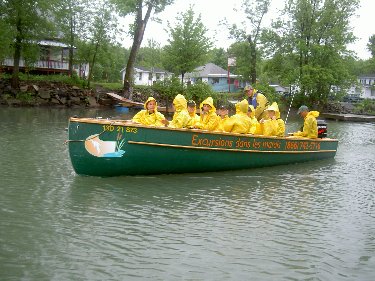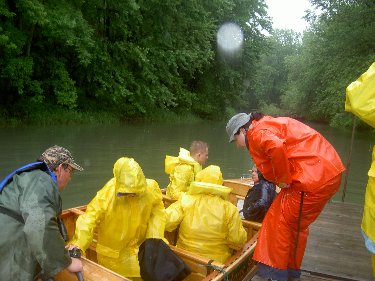|
|
Habeeb Salloum QUEBEC’S LAC SAINT-PIERRE BIOSPHERE RESERVE |
|
Introduction
To begin a trip through one of the fascinating natural spots in Quebec, one must leave Montreal behind and travel to the Lac Saint-Pierre Biosphere Reserve.
The Journey
The rain was pouring when we left Montreal to begin our journey of touring the Lac Saint-Pierre Biosphere Reserve – a nearby natural part of Quebec preserved for the coming generations. It had not let up when, after an hour’s drive, our bus stopped in front of a boathouse in the Lake Saint-Pierre archipelago at the merging of the St. Lawrence, Yamaska and Richelieu Rivers. Quickly our group of twelve scurried into the boathouse and were soon donning bright yellow rainwear. As we walked down to a tiny dock where two small boats were waiting for us, one of our group members remarked, “Look at us! Don’t we look like penguins waddling to the water?”
A few minutes later our two boats, each with a guide, were making their way through the winding water channels of the Biosphere Reserve - a huge wetland area saturated with water encircled islands. The Reserve stands at the mouth of the 100 km (61 mi) long Richelieu River - the heart of the most strategic river networks in North America. Linking the St. Lawrence with Lake Champlain and by canals to the Hudson River, this collection of waterways was once a part of a crucial water system running between Montreal and New York. Before being discovered by Samuel de Champlain, the Iroquois Indians used the waterways as a pathway for trade and war. After the British and French colonization of eastern North America, it became an important pathway for traders as well as a roadway of invasions and counter invasions by the British, French and, later, the Americans. Above all, until the advent of the railway it was the route by which the riches of the continent were conveyed to the Atlantic coast. Today, travelling through this magnificent far-flung heritage corridor, pleasure boaters and other water enthusiasts as well as bikers and hikers have taken over the once birch bark canoes, commercial steamships, warships and forest adventurers. The complex of waterways, edged by a fertile landscape, continues to be an important pathway for those seeking the pleasures of the outdoors and the excitement of water travel. However, if the modern outdoors people want to experience the real untarnished outdoors, the Lac Saint-Pierre Biosphere Reserve, noted for the richness of its wetlands, is the place to explore. Recognized by UNESCO as a World Biosphere Reserve in 2001, the area edging the city of Sorel-Tracy, includes 103 islets and water channels, making up 40% of all the St. Lawrence wetlands. These shelter an exceptionally rich plant and animal life. Known for its unique ecosystem, the area is a vital stop along this migratory route and 288 species of resident and transient birds - home to more than 167 species of these birds. Close to 70 species of fish are to be found in the Biosphere and it is the largest freshwater waterfowl staging area on the St. Lawrence. It is also the nesting spot, in its protected habitats, to the largest heron colony in North America. The Biosphere, edging a major waterway and an industrialized area, is an unusual example in the World Network of Biosphere Reserves. One of the major components of the St. Lawrence lowlands, it is edged by the St. Lawrence Seaway, one of the most used inland waterways of the world. However, the industrial establishments have been forced to green their practices and, hence, water quality has shown a continuing improvement over the last decade. Today, Lac Saint-Pierre Biosphere Reserve has become a true link between the environment and the economy. As we glided along in the water, I could see through the mist of lightly falling rain the beautiful flora with trees whose roots like those of the mangrove trees were growing out of the water. All the islands were covered with a thick layer of greenery, dotted here and there by tiny babbling waterfalls, bird nests and cottages built on stilts by the city folks who come here to fish or just enjoy the wonders of the outdoors. However, no one can inherit these cottages and soon these summer homes will fade away when the present owners are gone. I was watching a half dozen ducks swimming nearby when I felt a mosquito bite my hand. “I hate mosquitos!” I said aloud, noting that Paul, our guide was watching me scratch my hand. He smiled, “Just don’t come here after 6 P.M. without a huge amount of bug killer.” We relaxed in our wet boats as we moved in the shade of gigantic trees, all the while listening to the chirping of birds hidden in the shrubs with others flying overhead. It was an undisturbed and calming atmosphere - nature as it was meant to be. In this world of dreams where one can easily escape from the overwhelming present, my seat companion sighed, “It’s an idyllic haven! I don’t even feel the rain. It’s so peaceful here”. For Further Information, Contact: Tourisme Montrégie, 11, chemin Marieville, Rougemont (Québec), Canada J0L 1M0 Tel : (450) 469-0069 or Montréal : (514) 990-4600. Toll free : 1-866-469-0069 Fax : (450) 469-1139. E-mail: info@tourisme-monteregie.qc.ca Website: http://www.tourisme-monteregie.qc.ca/
The Chapters of QUEBEC’S LAC SAINT-PIERRE BIOSPHERE RESERVE...
| ||||||||||||||||

